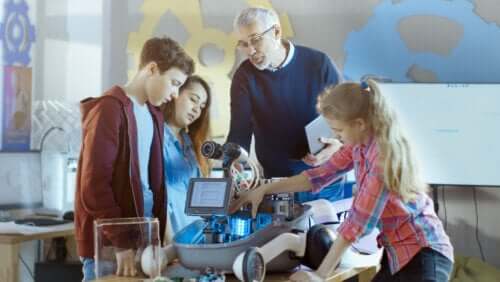The Four Pillars of Learning According to Jacques Delors


Written and verified by the social educator Natalia Cobos Serrano
In 1996, UNESCO published Learning: The Treasure Within, an extremely popular document in the educational world. It was written by Jacques Delors from the International Commission. It explains the four pillars of learning: learning to know, learning to be, learning to live together, and also learning to do.
To face the challenges of the 21st century, Delors understood that education had to accept new objectives for the new millennium. In this way, he formulated these four pillars of learning. They were created to respond to the new educational and social panorama that was taking shape in our societies.
“A new, broader conception of education should lead each person to discover, awaken, and increase his or her creative possibilities.”
– Jacques Delors –
The four pillars of learning: what do they consist of?
Learning to know
Delors defines this pillar of learning as a means and an end for human development. He explains that the goal isn’t merely the acquisition of knowledge. His opinion is that it’s all about the mastery of the very instruments of knowledge.
This type of learning is key for each child. The aim here is for them to learn to understand the world around them in order to feel the pleasure of understanding, knowing and discovering.

“The increase of knowledge (…) favors the awakening of intellectual curiosity and stimulates critical sense. It also allows the deciphering of reality, enabling them to acquire at the same time an autonomy of judgment.”
– Jacques Delors –
Learning to be
One of the fundamental principles established by the International Commission was that education should also contribute to each person’s overall development.
According to Delors, education has the imperative function of giving all human beings the freedom of thought, judgment, feeling and imagination. He says that they need these in order to promote their talents to the fullest.
In his paper, Delors reflects on this area. He says that, in order to achieve this, it’s key to allow room for imagination and creativity, which are necessary for our ever-changing world.
Learning to live together, learning to live with others
Learning to live together consolidates the task of teaching children that coexistence is a necessity. This is especially so in our current social context.
Efforts to awaken and, ultimately, exalt the ideology of competitiveness at professional levels are also reaching our classrooms. This is having a profound effect on the way children communicate and relate to each other. It also has an effect on their way of perceiving the world.
Therefore, it’s essential that our schools create a quality educational project based around coexistence and the criterion of equality. This will help all students to discover new knowledge together, as they participate in common projects together.
Learning to do, the great challenge of the four pillars of learning
Finally, regarding learning to do, Delors points out that this type of learning is necessary in order to exert an influence on what surrounds us.
He also explains the direct relationship of this type of learning with the professional world. In this way, he highlights the importance of the role of education in the development of communication skills and the ability to work with others. In addition to this, it will help children to know how to face and resolve conflicts.

“Education is forced to provide the nautical charts of a complex world in perpetual turmoil and, at the same time, the compass to be able to navigate in it.”
– Jacques Delors –
Have we fulfilled the expectations for the 21st century?
To be honest, there’s still a long way to go when it comes to implementing these four pillars of learning. There’s still work to be done in order to help them to better understand our world, and to learn to do and to be. The hope is that they’ll be able to use this knowledge to develop in all these areas and learn how to truly co-exist with other people
However, having said that, the concept of education from 20 years ago has changed in certain essential aspects. For example, competency-based education is a new ideology and educational outlook that turns the focus away from the mere accumulation of knowledge.
The aim of this new approach is to focus attention on the importance of educating our children and young people to enable them to develop well and adapt to our ever-changing society.
In 1996, UNESCO published Learning: The Treasure Within, an extremely popular document in the educational world. It was written by Jacques Delors from the International Commission. It explains the four pillars of learning: learning to know, learning to be, learning to live together, and also learning to do.
To face the challenges of the 21st century, Delors understood that education had to accept new objectives for the new millennium. In this way, he formulated these four pillars of learning. They were created to respond to the new educational and social panorama that was taking shape in our societies.
“A new, broader conception of education should lead each person to discover, awaken, and increase his or her creative possibilities.”
– Jacques Delors –
The four pillars of learning: what do they consist of?
Learning to know
Delors defines this pillar of learning as a means and an end for human development. He explains that the goal isn’t merely the acquisition of knowledge. His opinion is that it’s all about the mastery of the very instruments of knowledge.
This type of learning is key for each child. The aim here is for them to learn to understand the world around them in order to feel the pleasure of understanding, knowing and discovering.

“The increase of knowledge (…) favors the awakening of intellectual curiosity and stimulates critical sense. It also allows the deciphering of reality, enabling them to acquire at the same time an autonomy of judgment.”
– Jacques Delors –
Learning to be
One of the fundamental principles established by the International Commission was that education should also contribute to each person’s overall development.
According to Delors, education has the imperative function of giving all human beings the freedom of thought, judgment, feeling and imagination. He says that they need these in order to promote their talents to the fullest.
In his paper, Delors reflects on this area. He says that, in order to achieve this, it’s key to allow room for imagination and creativity, which are necessary for our ever-changing world.
Learning to live together, learning to live with others
Learning to live together consolidates the task of teaching children that coexistence is a necessity. This is especially so in our current social context.
Efforts to awaken and, ultimately, exalt the ideology of competitiveness at professional levels are also reaching our classrooms. This is having a profound effect on the way children communicate and relate to each other. It also has an effect on their way of perceiving the world.
Therefore, it’s essential that our schools create a quality educational project based around coexistence and the criterion of equality. This will help all students to discover new knowledge together, as they participate in common projects together.
Learning to do, the great challenge of the four pillars of learning
Finally, regarding learning to do, Delors points out that this type of learning is necessary in order to exert an influence on what surrounds us.
He also explains the direct relationship of this type of learning with the professional world. In this way, he highlights the importance of the role of education in the development of communication skills and the ability to work with others. In addition to this, it will help children to know how to face and resolve conflicts.

“Education is forced to provide the nautical charts of a complex world in perpetual turmoil and, at the same time, the compass to be able to navigate in it.”
– Jacques Delors –
Have we fulfilled the expectations for the 21st century?
To be honest, there’s still a long way to go when it comes to implementing these four pillars of learning. There’s still work to be done in order to help them to better understand our world, and to learn to do and to be. The hope is that they’ll be able to use this knowledge to develop in all these areas and learn how to truly co-exist with other people
However, having said that, the concept of education from 20 years ago has changed in certain essential aspects. For example, competency-based education is a new ideology and educational outlook that turns the focus away from the mere accumulation of knowledge.
The aim of this new approach is to focus attention on the importance of educating our children and young people to enable them to develop well and adapt to our ever-changing society.
All cited sources were thoroughly reviewed by our team to ensure their quality, reliability, currency, and validity. The bibliography of this article was considered reliable and of academic or scientific accuracy.
- Delors, J. (1996). Los cuatro pilares de la educación en la Educación encierra un tesoro. Informe de la UNESCO de la Comisión internacional sobre la educación para el siglo XXI pp. 91-103. Santillana. España: Madrid. Disponible en: http://dspace.ucuenca.edu.ec/bitstream/123456789/30016/1/169-619-1-PB.pdf
- Pérez Pérez, C. (1999). Educación para la convivencia como contenido curricular: propuestas de intervención en el aula. Estudios pedagógicos (Valdivia), (25), 113-130. https://scielo.conicyt.cl/scielo.php?pid=S0718-07051999000100007&script=sci_arttext
- Vergara, A. (2017). El papel del docente, el ejemplo y el maestro en la enseñanza de la medicina; 32:9-11. https://www.redalyc.org/journal/3555/355550587001/html/
This text is provided for informational purposes only and does not replace consultation with a professional. If in doubt, consult your specialist.








